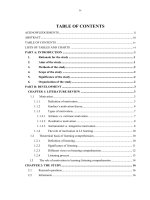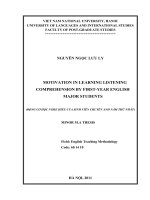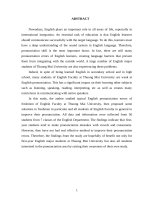Motivation in Learning Listening Comprehension by First-Year English Major Students
Bạn đang xem bản rút gọn của tài liệu. Xem và tải ngay bản đầy đủ của tài liệu tại đây (157.65 KB, 9 trang )
Motivation in Learning Listening
Comprehension by First-Year English Major
Students
Nguyễn Ngọc Lưu Ly
Trường Đại học Ngoại ngữ
Luận văn ThS. Chuyên ngành: Theory and methodology of English teaching
Mã số: 60 14 10
Người hướng dẫn: Hà Cẩm Tâm. Dr.
Năm bảo vệ: 2011
Abstract: This study investigates the integrative and instrumental motivation of HUI‟s
first-year English majors toward learning listening comprehension. In order to determine
their tendency toward the two kinds of motivation in learning listening comprehension,
the data were collected by quantitative method, i.e. using Zahra Vaezi (2008)‟s modified
25-item survey questionnaire which was adapted from Gardner (1985) ‟s AMTB and
Clement et al.‟s (1994). The questionnaire was delivered to 30 first-year English majors
at Ho Chi Minh University of Industry. The study reveals that the students possess very
high motivation and positive attitudes toward learning listening comprehension. In
addition, the paper shows that they are more instrumentally than integratively motivated
to learn listening comprehension.
Keywords: Tiếng Anh; Kỹ năng nghe hiểu; Nghe hiểu
Content
PART A: INTRODUCTION
1. Rationale for the study
Motivation, believed as one of the most important factors determining the rate and success
of second language (L2) attainment, provides the primary impetus to initiate learning the L2 and
later the driving force to sustain the long and often tedious learning process (Dornyei, 2001, cited
in Ha 2009, p163). Research shows that motivation is crucial for L2 learning (Dornyei, 1994).
According to Oxford and Shearin (1994, cited in Ha 2009, pp.163-164), motivation directly
influences how much effort students make, how often students use L2 learning strategies, how
much students interact with native speakers, how much input they receive in the language being
learned, how well they do on curriculum related achievement tests, how high their general
proficiency level becomes, and how long they preserve and maintain L2 skills after language
study is over (Ely 1986, Oxford & Shearin 1994). Particularly, toward learning listening
comprehension, which is assuming a more and more important place in foreign language
teaching and learning process, and is probably one of the most difficult tasks of language
learners, motivation is one important element directly influencing their achievement. “Motivation
is the crucial force which determines whether the listener embarks on a task at all. The primary
motive for learning a language is that it provides a means of communication” (Littlewood,
1984:53). Brown (2000:143, 160) asserts, “It is easy in SLL to claim that a listener will be
successful with the proper motivation.”
Having recognized the importance of motivation on learning listening comprehension, this
study focuses on Motivation in learning listening comprehension by first-year English major
students. This study will examine the students‟ goals of learning listening comprehension, in
other words, their tendency towards the integrative and instrumental motivation in learning
listening comprehension.
2. Aims of the study
The study is to describe and examine the students‟ integrative and instrumental motivation
towards English language learning. In other words, the study aims to determine their tendency
toward the two types of motivation.
3. Methods of the study
In this study, quantitative method was used. The data were collected via questionnaire. The
modified questionnaire was based on Vaezi (2008)‟s 25-item survey questionnaire which was
adapted from Gardner (1985)‟s AMTB and Clement et al.‟s (1994).
4. Scope of the study
The study describes and examines the students‟ integrative and instrumental motivation
towards English language learning, in particular listening comprehension.
5. Significance of the study
First, the information about the students‟ integrative and instrumental motivation towards
listening comprehension learning, in other words, the information about their goals of learning
listening comprehension is useful for those who teach English, especially listening
comprehension to non-English major students in general and for those who teach English to
students majoring in English at HUI in particular. As a result, the study also gives some
suggestions and recommendations for all teachers when teaching listening comprehension.
6. Organization of the study
The study consists of five chapters.
Part A – Introduction. This chapter discusses the rationale, aims, scope, methods, significance
and design of the study.
Part B – Development consists of two chapters:
Chapter 1 - Literature Review- this chapter is intended to give some theoretical background
related to motivation and listening comprehension.
Chapter 2 - The study – In this chapter, the collection instruments, data collection and data
analysis and discussion are presented.
Part C – Conclusion – this chapter presents the major findings, conclusion, implications, and
suggestions for further studies.
References
Anderson, A., & Lynch, T. (1988). Listening. Oxford: Oxford University Press.
Anderson, J. R. (1983). The architecture of cognition. Cambridge, Mass: Harvard University
Press.
Bever, T.G (1970). The cognitive basis for linguistic structures. In: J.R. Hayes, Editor, Cognition
and the development of language, Wiley, New York (1970), pp. 279–362.
Brown, H. D. (1994). Teaching by principles: An interactive approach to language pedagogy.
NJ: Prentice Hall Regents.
Brown, H. D. (2000). Principles of language learning and teaching. New York: Longman.
Brown, H. D. (2001). Teaching by principles: an interactive approach to language pedagogy,
second edition. New York: Pearson Education.
Carrell, P. & Eisterhold, J.C. (1983). „Schema Theory and ESL Reading Pedagogy‟. TESOL
Quarterly, 17/4: 553-73.
Carroll, John B. (1972). „Defining Language Comprehension: Some Speculations‟. Chapter 1 in
Carroll and Freedle (eds) (1972). Language comprehension and the Acquisition of knowledge.
New York: Wiley.
Chaudron, C. & Richards, J.C. (1986). The effect of discourse markers on the comprehension of
lectures. Applied Linguistics, 7, 113-127.
Chen Ling (2008). Study on affective factors on listening performance of English majors in
Xinjiang Agricultural University. US-China Foreign Language, Mar. 2008, 6 (3).
Clark, H. H., & Clark, E. V. (1977). Psychology and language: An introduction to
psycholinguistics. New York: Harcourt Brace Jovanovich.
Clement, R., Z. Dornyei & K.A. Noels (1994). Motivation, self-confidence and group cohesion
in the foreign language. Language Learning, 3:417-448.
Conrad, L. (1985). Semantic versus syntactic cues in listening comprehension. Studies in Second
Language Acquisition, 7 (1), 59-72.
Crookes, G. & Schmidt, R. (1991). Motivation: Reopening the research agenda. Language
Learning, 41(4), 469-512.
de Beaugrande, R.A, & Dressler. (1981). Introduction to text linguistics. London: Longman.
Deci, E. L., & Ryan, R. M. (1985). Intrinsic motivation and self-determination in human
behavior. New York: Plenum.
Dornyei, Z. (1994). Motivation and motivating in the foreign classroom. Modern Language
Journal, 78, 273-284.
Dornyei, Z. (1998). Motivation in second and foreign language learning. Language Teaching, 31,
117-35.
Dornyei, R. (2001). Teaching and Researching Motivation. Longman.
Dornyei, Z. (2001). Motivational strategies in the Language Classroom. Cambridge University
Press.
Ellis, R. (1997). Second Language Acquisition. Oxford: Oxford University Press.
Ely, C. M. (1986). Language Learning Motivation: A Descriptive and Causal Analysis. The
Modern Language Journal 70, 28-35.
Finegan, Edward. 1994. (1989). Language. Its Structure and Use. Orlando: Harcourt Brace.
Gardner, R. C. & Lambert, W.E. (1959). Motivational variables in second-language acquisition.
Canadian Journal of Psychology, 13, 266-272.
Gardner, R. C. & Lambert, W.E. (1972). Attitudes and Motivation in second language Learning.
Roley: Mass-Newsbury House.
Gardner, RC. (1985). Social Psychology and second language learning: The roles of attitudes
and motivation. London: Edward Arnold.
Gardner, R. C., & Tremblay, P. F. (1994). On motivation, research agendas, and theoretical
frameworks. Modern Language Journal, 78, 359-368.
Ha, Viet Le & Hoa, Van Phan (2009). Nghiên Cứu Về Động Cơ Học Tiếng Anh Của Học Sinh
Trung Học Phổ Thông ở Quảng Nam (An Investigation into English Learning Motivation of
Upper Secondary School Students in Quang Nam Province). Tap chi Khoa hoc Cong Nghe, Dai
hoc Da Nang-So 5(34), 2009, pp.163-171.
Harmer, J. (1991). The practice of English Language Teaching. London: Longman.
Harmer, J. (1999). The Practice of English Language Teaching. 2nd ed. Longman.
Hasan, A. S. (2000). Learners‟ perceptions of listening comprehension problems. Language,
culture and curriculum, 13(2), 137-153.
Hashimoto (2002). Motivation and willingness to communicate as predictors of L2 use: The
Japanese ESL context Second Language Studies, 20(2), Spring 2002, pp. 29-70.
Hedge, T. (2000). Teaching and Learning in the Language Classroom. Oxford: Oxford
University Press, pp. 230-235.
Howatt, A. & J. Dakin. (1974), Language laboratory materials, ed. J. P. B. Allen, S. P. B. Allen,
and S. P. Corder.
Hudson, G. (2000). Essential Introductory Linguistics. Blackwell Publishers.
Lan, Thi Luu (2008). Factors affecting motivation in learning speaking English of grade 10
students at Yendinh 1 high school.
Littlewood, T.W. (1984). Foreign and Second Language Learning, CUP.
Long, D. R., & Macián, J. L. (1994). Listening skills: Acquisition and assessment. In C. Hancock
(Ed.), Teaching, testing, and assessment: Making the connection (Northeast Conference Reports,
pp. 111-138). Lincolnwood, IL: National Textbook Company.
Lucas, R.I. (2010). A Study on the Intrinsic Motivation Factors in Second Language Learning
Among Selected Freshman Students. Philippine ESL Journal, Vol. 4, February 2010, p.6.
Lund, R.J. (1991).A comparison of second language listening and reading comprehension. The
modern language journal, 75, 196-204.
Marslen - Wilson, W., & Tyler, L. K. (1980). The temporal structure of spoken language
understanding. Cognition, 8, 1-71.
Masgoret, A.M. and R.C Gardner (2003). Attitudes, Motivation and Second Language Learning:
A Meta-Analysis of Studies Conducted by Gardner and Associates. Language Learning, 53:123-
163.
Mendelssohn, D.J. (1984). There are strategies for listening. TEAL Occasional Papers, 8, 63-76.
Morley J. (1991), Listening comprehension in second/foreign language instruction, in M. Celce-
Murcia (Ed.), Teaching English as a second or foreign language (pp. 81-106). Boston, MA:
Heinle & Heinle.
Murjani, W.T. (2010). Increasing student listening comprehension using storytelling: an action
research at the second year of SMK Harapan Kartasura. Research paper submitted as partial
fulfillment of the requirements for getting Bachelor Degree Of education in English Department.
Neisser, U. (1982). Snapshots or benchmarks? In U. Neisser (Ed.), Memory observed:
Remembering in natural contexts (pp. 43-48). San Francisco: Freeman
Nunan, D. (1991). Language teaching methodology. Hertfordshire: Prentice Hall International.
Nunan, D. (1995). Communicative Approaches to Listening comprehension. Language teaching
methodology- A textbook for teachers, pp. 17-25. Europe: Prentice Hall.
Nunan, D. (1997). Listening in Language Learning. The language teacher. t-
publications.org/tlt/files/97/sep/nunan.html
Nunan, D. (2002). Listening in language learning, In J.C. Richards & W.A. Renandya (Eds.).
Methodology in language teaching: An anthology of current practice (pp. 238-241). Cambridge,
UK: Cambridge University Press.
O'Malley, J.M., Chamot, A.U., & Küpper, L. (1989). Listening comprehension strategies in
second language acquisition. Applied Linguistics, 10(4), 418-437.
Oxford, R. L. & Shearin, J. (1994). Language Learning Motivation: Expanding the Theoretical
Framework. The Modern Language Journal, 78, 12-28.
Reece, I. & Walker, S. (1997). Teaching, Training and Learning. A Practical Guide. (Third Ed.).
Great Britain: Business Education Publishers Limited.
Richards, J.C. (2006). Materials development and research-Making the connection. RELC
Journal, 37.1, 5-26.
Rivers, V. M. (1992). Communicating Naturally in a Second Language. Cambridge: Cambridge
University Press, 243 p.
Ronald, Katharine, & Roskelly, Hephzibah (1985)."Listening as an act of composing". Paper
presented at the 36th Conference on College Composition and Communication, 1985. 12pp. [ED
257 094]
Root, E. (1999). Motivation and Learning Strategies in a Foreign Language Setting: A Look at a
Learner of Korean. Department of English as a Second Language University of Minnesota,
November 1999.
Rost, M. (1991). Listening in action. London: Prentice Hall.
Rost, M. (1994), Introducing listening, London: Penguin.
Rost, M. (2002). Teaching and Researching Listening. London: Longman.
Rubin, J. (1995). An overview to a guide for the teaching of second language listening. In D. J.
Mendelssohn & J. Rubin (Eds), A guide for the teaching of second language listening, pp. 7-11.
San Diago: Dominie Press.
Saha, M. & Talukdar, R. A. (2008). Teaching listening as an English Language Skill.
/>h_language_skill.html
Scarcella, R. C., & Oxford, R. L. (1992). The tapestry of language learning: the individual in the
communicative classroom. Boston, MA: Heinle & Heinle.
Tsui, A. B. M., & Fullilove, J. (1998). Bottom-up or top-down processing as a discriminator of
L2 listening performance. Applied Linguistics, 19, 4, 432-451.
Williams, M. & Burden, R. L. (1997). Psychology for Language Teachers: a Social
Constructivist Approach. Cambridge: Cambridge University Press.
Wilt, Miriam E. (1950). "A study of teacher awareness of listening as a factor in elementary
education”. Journal of Educational Research, 43 (8), April 1950, pp. 626-636.
Vandergrift, L. (1997). The comprehension strategies of second language (French) listeners: A
descriptive study, Foreign Language Annals, 30 (3), pp. 387-409.
Vandergrift, L. (1999). Facilitating second language listening comprehension: acquiring
successful strategies. ELT Journal, July 1999, 53/3, pp.168-176. Oxford University Press, 1999.
Yang, T. S. (1996). A study of English listening curriculum in a foreign language department.
Research report submitted to Ministry of Education Advisory Office Information in the Republic
of China (85-1-M-014). Taipei, Taiwan.
Yau Tsai (1993). A Study of Listening Comprehension Instruction for Chinese Junior-College
Students in Taiwan.
Vaezi, Z. (2008). Language Learning Motivation among Iranian Undergraduate Students. World
Applied Sciences Journal, 5(1): 54-61, 2008.
20100511152440817.doc
0.99.pdf









